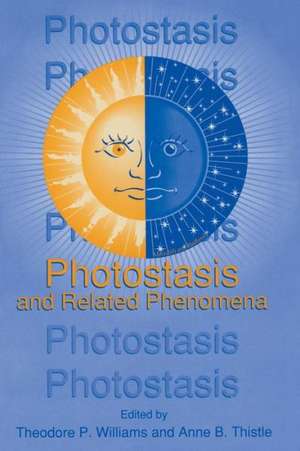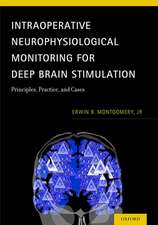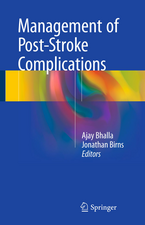Photostasis and Related Phenomena
Editat de Theodore P. Williams, Anne B. Thistleen Limba Engleză Paperback – 9 iun 2013
| Toate formatele și edițiile | Preț | Express |
|---|---|---|
| Paperback (1) | 1091.14 lei 6-8 săpt. | |
| Springer Us – 9 iun 2013 | 1091.14 lei 6-8 săpt. | |
| Hardback (1) | 1096.81 lei 6-8 săpt. | |
| Springer Us – 30 mai 1998 | 1096.81 lei 6-8 săpt. |
Preț: 1091.14 lei
Preț vechi: 1148.56 lei
-5% Nou
Puncte Express: 1637
Preț estimativ în valută:
208.78€ • 218.58$ • 172.76£
208.78€ • 218.58$ • 172.76£
Carte tipărită la comandă
Livrare economică 05-19 aprilie
Preluare comenzi: 021 569.72.76
Specificații
ISBN-13: 9781489915511
ISBN-10: 1489915516
Pagini: 240
Ilustrații: XII, 225 p.
Dimensiuni: 155 x 235 x 13 mm
Greutate: 0.34 kg
Ediția:Softcover reprint of the original 1st ed. 1998
Editura: Springer Us
Colecția Springer
Locul publicării:New York, NY, United States
ISBN-10: 1489915516
Pagini: 240
Ilustrații: XII, 225 p.
Dimensiuni: 155 x 235 x 13 mm
Greutate: 0.34 kg
Ediția:Softcover reprint of the original 1st ed. 1998
Editura: Springer Us
Colecția Springer
Locul publicării:New York, NY, United States
Public țintă
ResearchDescriere
Over the weekend of 21-23 February 1997, a small group gathered in Tallahassee, Florida, at the invitation of Ted Williams, to discuss "photo stasis and related topics." The majority of participants were former students and colleagues of Ted's, but an occasional outsider such as myself was generously included. The papers presented there are collected in this volume. The theory of photo stasis was first outlined in a landmark paper by John Penn and Ted, published in 1986 in Experimental Eye Research. They provided compelling data showing that, in the albino rat eye, levels of rhodopsin, outer-segment length, rhodopsin regeneration rate, and even, perhaps, rhodopsin packing density all depend on the levels of cyclic illumination (12 hours light, 12 hours dark) in which the animal was reared. So, for example, there is fourfold less rhodopsin in a retinal extract derived from an animal reared at 400 lux than in an extract from the retina of an animal reared at 3 lux. Animals reared at intermediate levels of light show intermediate amounts of rhodopsin that are correlated with illumination level. What these data immediately suggested is that the photoreceptor cell can adjust its photon-catching ability in response to the levels of light in which an animal is reared, and they also provided a compelling rationale for outer-segment turnover, a phenomenon discovered 20 years earlier by Richard Young but whose function has remained obscure.
Cuprins
Early Studies of the Photostasis Phenomenon: Retinal Adaptation to the Light Environment; J.S. Penn. Light History and Photostasis: What Is a `Normal' Rat Retina?; T.P. Williams. Hints of Photostasis in Invertebrates; S.C. Chamberlain, W.W. Weiner. Regulation of Rhodospin Expression in Rhabdomeral Photoreceptors: Functional Analysis of the 5' Flanking Region of the Calliphora Rh1 Opsin Gene; A. Huber, R. Paulsen. Rod Outer Segment (ROS) Renewal: An Underlying Mechanism for Maintaining Photostasis; J.-L. Schremser-Berlin. Environmental Light and Age-Related Changes in Retinal Proteins; D.T. Organisciak, et al. The Origin of the Major Rod- and Cone-Driven Components of the Rodent Electroretinogram and the Effect of Age and Light-Rearing History on the Magnitude of These Components; E.N. Pugh, et al. Effects of Photoresponse Prolongation on Retinal Rods of Transgenic Mice; C.L. Makino, et al. Photostasis: Implications for Pineal, Circadian, and Visual Photosensitivity; Z. Boulos, M. Terman. Circadian Regulation of Vertebrate Photoreceptors: Rhythms in the Gating of Cationic Channels; S.E. Dryer, et al. 3 Additional Articles. Index.
Recenzii
`....The volume can be highly recommended to those who wish an updated review of the theory of photostasis.'
Acta Opthalmologica Scandinavica, 77:2 (1999)
Acta Opthalmologica Scandinavica, 77:2 (1999)














